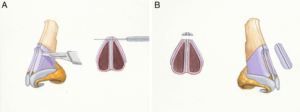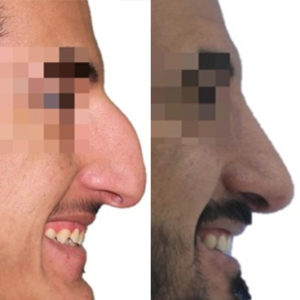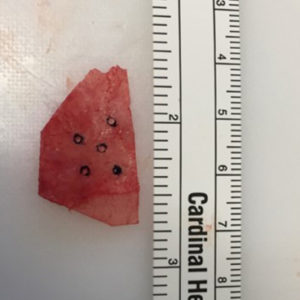Corresponding Author:Ira Papel, MD The authors have nothing to disclose. Abstract/Synopsis: The facial plastic and reconstructive surgeon must carefully consider both nasal form and function to successfully perform rhinoplasty surgery. This chapter highlights important nasal anatomy, preoperative considerations, and various techniques to improve the structural support of the alae. Structural techniques involving cartilage grafts, suture… [Read More]
Rhinoplasty
Augmentation Rhinoplasty Using Alloplastic Implants
It is generally agreed that autologous tissue is the material of choice for the rhinoplasty. Alloplastic materials are inherently subject to risks of bacterial infection, extrusion, migration and other problems. However, it is often overly emphasized or exaggerated for the risks of alloplastic materials by experts. Complications from alloplastic implants in rhinoplasty may decrease with… [Read More]
The Butterfly graft
The authors have no relevant financial disclosures or conflicts of interests to disclose. No funding or external support was provided for the development of this manuscript. Abstract Nasal airway obstruction is one of the most common complaints seen by otolaryngologists and the septoplasty is one of the most common operations performed. Despite this, many patients… [Read More]
The Dorsal Hump
Introduction: Rhinoplasty is one of the most difficult procedures in the field of facial plastic. There is significant number of patients end up with poor outcomes. Many of these poor outcomes could be avoided by good surgical judgment and decision making. To achieve a very efficient dorsal hump, a proficiency of skills and technique, an… [Read More]
Tip onlay graft: the Peck graft revisited
Corresponding author for proof Alessandro Varini, MDCasa di Cura Salus, Trieste, ItalyVia Bonaparte 4, 34123 Trieste, Italyvarini.alessandro@gmail.comTel +390403171111 Coauthors addresses: Nicola Bianco, MD, PhDCasa di Cura Santa Rita, Atripalda (Avellino), ItalyVia Appia snc, 83042 Atripalda (Avellino), Italydottnicolabianco@gmail.comTel +390825629111 Cristina Diana, MDCasa di Cura Santa Maria, Bolzano, ItalyVia Claudia dè Medici 2, 39100 Bolzano, Italycristina.diana@alice.itTel +390471310600… [Read More]
The Surgical Management of the Severe Nasal Saddle Deformity
Introduction Generations of rhinoplasty surgeons have struggled to find a way to correct and consistently manage saddle deformities of the nasal dorsum. These deformities of the nasal framework can lead to devastating emotional and psychological effects in patients1. The more common causes that can lead to the development of these severe dorsal contour irregularities are… [Read More]
Tongue in groove technique for nasal tip positioning
Keywords: Rhinoplasty, nasal tip, projection, tongue in groove. Background The aesthetic surgical mastery of the lower third of the nose has long been recognised as one of the most challenging parts of doing rhinoplasty. Rhinoplasty surgeons use a variety of surgical techniques to obtain the desired aesthetic results. Surgeons over the years have tried a… [Read More]
Maximizing the septal graft: use of osteo-cartilaginous septal graft in rhinoplasty
Introduction The nose is a complex structure comprised of a bony-cartilaginous scaffold encased in a soft tissue envelope. These different tissue consistencies work intimately to develop the structure of the nose. In rhinoplasty, establishing form and function of this complex structure often requires grafting to the existing foundation. Conventionally, septorhinoplasty techniques often employ autogenous cartilaginous… [Read More]
The use of crushed cartilage grafts for camouflage and contouring in rhinoplasty
Disclosure: The authors have nothing to disclose. Keywords (4-8): Rhinoplasty, crushed cartilage, camouflage grafts, rhinoplasty augmentation, tip grafts Abstract Crushed cartilage grafts are a valuable option for slight augmentation and camouflage in rhinoplasty. In this chapter we describe our technique for preparing crushed cartilage in a systematic way as well as a classification system for… [Read More]
The Subalar Graft
Introduction The subalar graft, was developed to resolve the central facial skin surface anatomic asymmetries associated with a unilateral hypoplastic maxilla in the rhinoplasty patient. In addition to the common rhinoplasty patient complaints of nasal dorsal hump, wide nasal dorsum, boxy nasal tip, ptotic tip, projecting tip, etc. these patients exhibit a distinctive group of… [Read More]
- « Previous Page
- 1
- 2
- 3
- 4
- …
- 6
- Next Page »










